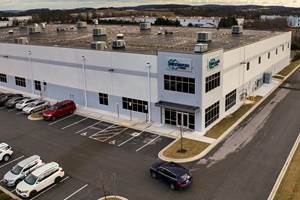Wind energy: A worldwide phenomenon
The wind energy industry is now operative in a genuinely worldwide marketplace.
Share
Read Next
Wind energy association WindEurope (Brussels, Belgium) reports that the wind industry contributes €36 billion to the European Union (EU) gross domestic product (GDP) and supports 263,000 jobs in Europe. At the end of June 2017, the European Union had a total of 159.5 GW of wind power capacity installed (48% in Germany). And the U.S. Wind Industry Fourth Quarter 2017 Market Report released by The American Wind Energy Assn. (AWEA, Washington, DC, US) reported 89 GW of wind power installed across 41 states “enough to power 26 million American homes” — attracting US$14 billion annually in private investment to US wind farms over the past decade and employing US 102,500 workers at the end of 2016. By that year’s end, wind had become the largest new source of electrical energy, outpacing coal, natural gas and hydro-electric sources.
According to Navigant Research (Chicago, IL, US), wind farm developers in the Asia-Pacific region led wind turbine order capacity with 2.8 MW of turbine orders signed in the first half of 2017. Navigant’s report, Wind Turbine Order Tracker 4Q17, says global wind turbine orders announced in the first half of 2017 reached 11.6 GW, representing a decline from 14.7 GW in the second half of 2016 and 13.4 GW in the first half of 2016. “Despite this year’s decrease in order capacity, the average turbine rating continues to grow, with many of the top turbine vendors having weight average ratings near 3 megawatts (MW) or higher. Total wind farm sizes are also increasing” says Adam Wilson, research analyst with Navigant Research.
Wind energy’s growth is now truly global in scope: Siemens Gamesa (Zamudio, Spain) alone reports that is has installed 700 MW in Turkey, has signed on to do 1 GW more there and has won a contract to provide wind company F.L. Wind with 18 G97 2-MW turbines for its 36-MW Jelovaca project in Bosnia and Herzegovina, according to the company. The company added that the order marks its second turbine supply deal within the country. Bosnian utility ERS also sought consultants in 2017 to help with the environmental and social scoping aspects of developing a 48-MW wind farm in the country, according to the company. The project is expected to feature 16 3-MW turbines. Saudi Arabia's Renewable Energy Project Development Office is planning to host at least two renewable energy leasing rounds this year, seeking developers for 800 MW worth of wind. Brazil, meanwhile, already has 13 GW of installed wind power capacity in 518 operational wind farms, according to its National Wind Energy Assn. Given current contracts, Brazil will reach nearly 19 GW of installed capacity by 2023, the organization says. And Thai solar firm Superblock has unveiled plans to add several wind farms with a combined capacity of 700 MW in Vietnam.
Notably, the Pyeongchang 2018 Olympic Winter Games were entirely powered by wind energy. Wind power generators were in operation in the Host Province in accordance with the Central Korea Renewable Energy Development Plan and Wind Energy Cluster Project. The total generation capacity reached 203 MW, exceeding the Games’ required capacity of 194 MW by 4%.
In all, the wind energy industry added 52.6 GW of new installed generating capacity in 2017, bringing the world's total to 539.581 GW, according to the Global Wind Energy Council (Brussels, Belgium). "The numbers show a maturing industry, in transition to a market-based system, competing successfully with heavily subsidized incumbent technologies," says Secretary-General Steve Sawyer.
Related Content
Achieving composites innovation through collaboration
Stephen Heinz, vice president of R&I for Syensqo delivered an inspirational keynote at SAMPE 2024, highlighting the significant role of composite materials in emerging technologies and encouraging broader collaboration within the manufacturing community.
Read MoreComposites end markets: Batteries and fuel cells (2024)
As the number of battery and fuel cell electric vehicles (EVs) grows, so do the opportunities for composites in battery enclosures and components for fuel cells.
Read MorePolar Technology develops innovative solutions for hydrogen storage
Conformable “Hydrogen in a Box” prototype for compressed gas storage has been tested to 350 and 700 bar, liquid hydrogen storage is being evaluated.
Read MoreHexagon Purus opens new U.S. facility to manufacture composite hydrogen tanks
CW attends the opening of Westminster, Maryland, site and shares the company’s history, vision and leading role in H2 storage systems.
Read MoreRead Next
VIDEO: High-volume processing for fiberglass components
Cannon Ergos, a company specializing in high-ton presses and equipment for composites fabrication and plastics processing, displayed automotive and industrial components at CAMX 2024.
Read MoreAll-recycled, needle-punched nonwoven CFRP slashes carbon footprint of Formula 2 seat
Dallara and Tenowo collaborate to produce a race-ready Formula 2 seat using recycled carbon fiber, reducing CO2 emissions by 97.5% compared to virgin materials.
Read MorePlant tour: Daher Shap’in TechCenter and composites production plant, Saint-Aignan-de-Grandlieu, France
Co-located R&D and production advance OOA thermosets, thermoplastics, welding, recycling and digital technologies for faster processing and certification of lighter, more sustainable composites.
Read More




















